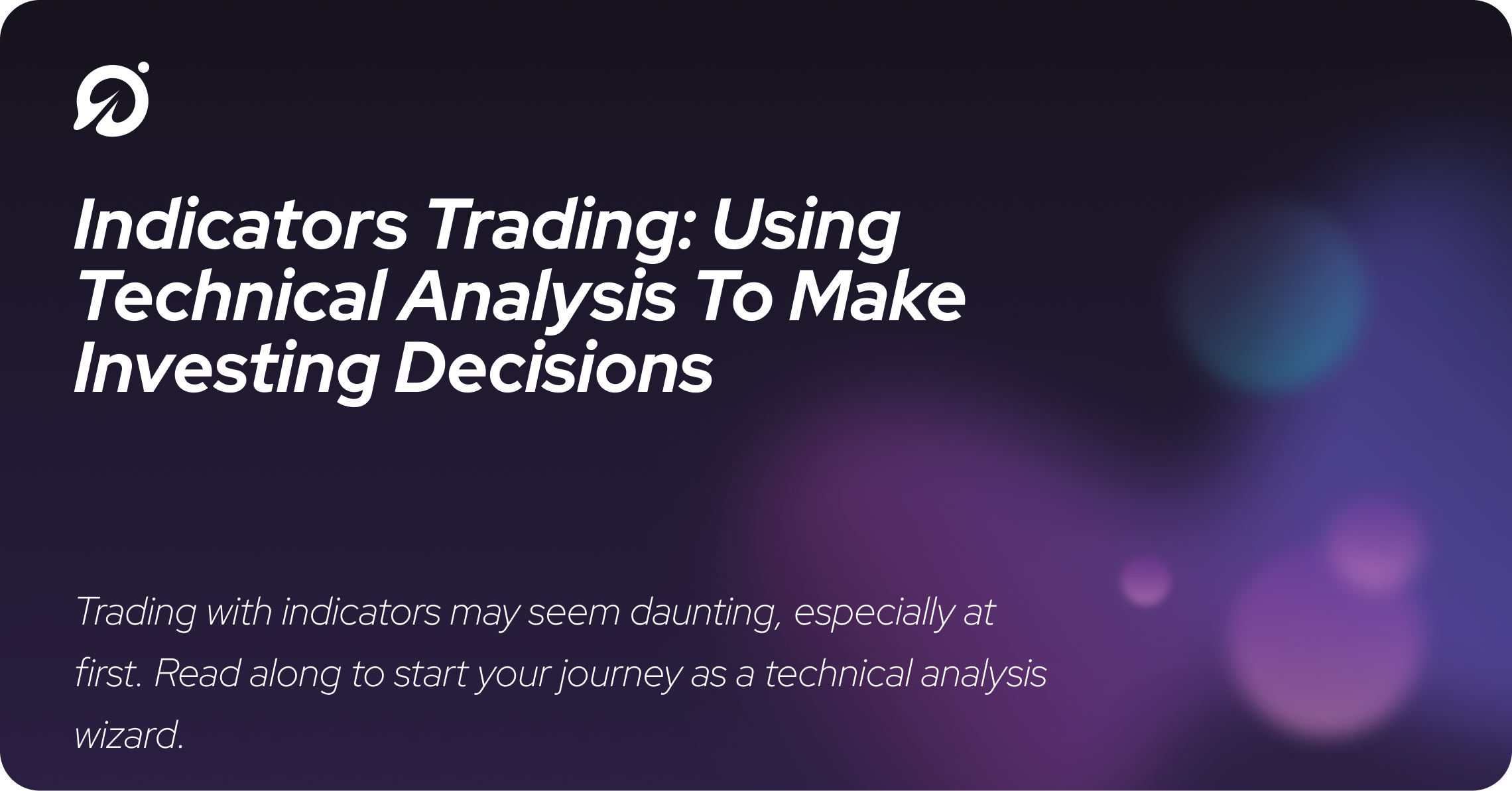Indicators Trading: Using Technical Analysis To Make Investing Decisions
Using technical analysis is a key way to level up your investments and hone your trading skills. Read on as Pluto dives into indicators trading to uncover everything you need to know.

Disclaimer: This is for informational purposes and is not meant to serve as financial or investing advice.
What Is Technical Analysis?
Whether you're an experienced trader or just starting, understanding technical indicators and how to use them can help you make intelligent investing decisions.
Technical analysis (or TA for short) uses past price movements and volume data to anticipate future price action. Indicators are mathematical calculations based on historical data overlaid onto a stock chart to help traders identify patterns.
Popular indicators include moving averages, RSI, MACD, Bollinger Bands, and stochastic oscillators. Moving averages are trendlines that smooth out an asset’s historical price movements. RSI and stochastic oscillators are relative momentum indicators for an asset. Bollinger bands help traders as a volatility indicator.
Of course, these indicators are tools you should use in conjunction with charting. Charting is a vital technical analysis component that uses candlesticks charts, trend patterns, and trendlines to evaluate trade decisions.
This article covers critical concepts about charting and trading indicators, risk management, and trading psychology — everything from moving averages to Ichimoku overlays. Keep reading to brush up on your TA game.
What Are the Key Concepts Related to Technical Analysis?
Knowing the main concepts behind technical analysis can help you build your foundational knowledge and make your investments work for you, not against you.
1. Charts
You’ve probably seen a stock chart before. It looks like a standard graph with time on the x-axis and price on the y-axis. Stock price over time is charted with a line. But variations to how the data is plotted can make a huge difference in your technical analysis.
The easiest way for beginners to step up their trading game is to ditch the line chart and switch to candles. Candles are rectangles (usually red and green) that give the trader information about trades executed within that period.
Red candles indicate the price ended lower than it started, and green candles mean the price increased. The upper and lower bounds of the candle indicate open and close prices, and the “wicks” or lines on the end of the rectangle indicate highs and lows.
So if you’re looking at the one-hour candle chart of a stock, you can instantly glean at least three extra data points for a given period compared to a line chart.
2. Identifying Patterns
Like an athlete develops muscle memory, traders can gain pattern recognition by following charts and looking for repeated trends. For example, a “bull hammer” is a candle pattern where a candle has an extended bottom wick.
This means sellers were outnumbered by buyers who supported the price when it dipped. It could indicate the market is eager to buy cheap shares that it expects to outperform.
Individual assets have unique behaviors and quirks that traders can learn from the charts. If you spot a familiar pattern, you can overlay a historical price chart on the current chart to understand where the price might be headed.
Another huge component of technical analysis is drawing. Traders love to draw on charts, lines, arrows, big red circles — anything to convey their thesis. Using software tools to draw on charts is a great way to see if your ideas play out.
Trendlines are probably the easiest way to get started. You can try connecting points on the peaks of candles to see if a stock consistently trades within a “channel.” Channels are zones that traders watch to see if a stock breaks out to inform short or long positions.
What Are Indicators?
Trading indicators help traders gain insights on stocks that can’t be gleaned from just looking at a chart. Indicators use mathematical formulas to display advanced data on price and trading volume. Traders use combinations of indicators to make trade decisions. These are sometimes called trading systems.
What Are the Types of Trading Indicators?
There are several different types of trading indicators to be aware of. Here are the main indicators to understand:
1. Moving Averages
A moving average is an indicator that averages an asset’s average price over a period of time and overlays it on the chart as a line. An SMA takes the average closing price of a stock over a period, usually in days. So the 10-day SMA is the average closing price of a stock for the last five days.
Weighted moving averages (WMAs) and exponential moving averages (EMAs) use weights to give more emphasis to recent price data. Traders often look for crossover points of different moving averages to inform trading decisions.
You can also compare the same moving average over different timeframes to identify reversals or price breakouts. Moving averages are an excellent tool for identifying new trends and avoiding pullbacks. They are often used as “trigger points” in technical trading strategies.
2. Oscillators
Oscillators use mathematical formulas to indicate if an asset is “overbought” or “oversold.” If an asset is deemed overbought, it’s overpriced.
The relative strength index, or RSI, is the most popular oscillator. It uses the change and magnitude of price swings to indicate an asset’s momentum. In short, a high RSI indicates a buying frenzy, and the price may enter a downtrend soon.
Stochastic oscillators use the closing price of an asset to generate momentum measurements for an asset. Stochastic oscillators range from zero to 100, with anything above 80 or below 20 indicating overbought and oversold conditions.
3. Bands
Bands are indicators that overlay ranges onto a trading chart with upper and lower bounds. The third band is a trendline in the middle. Bollinger Bands use the simple moving average as the trendline with upper and lower bounds representing the SMA +- 2 standard deviations.
Bollinger Bands are popular for momentum trading and indicate if an asset is oversold or overbought. The way Bollinger Bands are overlaid on a chart makes them beginner friendly, as they are visually intuitive.
4. Other Indicators
Once you’ve learned the standard trading indicators, you can go as deep as you want on trading indicators. There are thousands of custom indicators and strategies you can read about online, and even more tweaks you can make to create new ones.
At Pluto, we offer the best trading data and industry-leading strategies for you to use in your trading journey.
What Do You Need To Know About Trading Strategies?
Trading strategies using indicators use filters and trigger points to tell you when to enter a trade. Filters describe trading conditions, and trigger points indicate entry points.
For example, if your filter is RSI above 50 for a stock, the trigger point for the trading strategy could be a 10-day EMA crossing the 50-day EMA. Trade exits can follow similar criteria or take profit targets.
Advanced chart patterns like Fibonacci retracements and Ichimoku clouds can also be used to find support and resistance levels for entering or exiting trades.
Trigger points can also be when more than one indicator reaches the moving average convergence/divergence point.
Computer programmers and excel enthusiasts may recognize filters and trigger points as an if-then statement. If XYZ criteria are met or a trigger price is crossed, then make a trade.
The next logical step is to automate your trades using software to eliminate human error. You can learn more about investment strategies and automated trading on our Youtube channel.
What Is Risk Management?
Having a risk management strategy is non-negotiable for successful trading. “Capital preservation” is one of the most critical concepts for novice traders.
Developing strict risk management rules can remove the emotion from trading and prevent mistakes. All it takes is one lapse of risk management to blow up a trading account.
Trade Sizing
Trade sizing is the practice of ensuring no position in your portfolio is above a certain percentage. For example, you could limit trades to 10% of trading capital. That way, you can only lose 10% of your capital in the event of a drawdown.
Setting limits like this also helps position you best to make consistent profits. If a position performs well and becomes greater than 10% of your portfolio, you would take profits to reduce its size.
Stop Losses
Stop losses are orders that automatically execute when a trade goes wrong. Stop loss will be triggered in a long position if the price decreases a certain amount and vice versa with a short position.
You can customize stop losses to trigger at a specific price or a price range. You can even use trailing stops to trigger if the price falls a particular percentage off the highest market price. You can automatically lock in profits and cover your downside if the trade goes your way.
You can learn more about the different types of stop losses in our article about stop limit orders.
What Do You Need To Know About Trading Psychology?
Trading psychology can seem complicated, but it doesn’t have to be. Let’s talk about the basics of trading psychology, including bias, fear, and greed, so you can understand how it works and what to look out for.
Bias
Technical analysis can help you overcome biases. Emotional biases may cause you to FOMO into precarious positions or sell early during uncertainty. If you develop a robust trading system using trend indicators, you can minimize making mistakes due to your emotions.
Stocks and crypto aren’t just numbers on a screen. They have leaders and products that may influence your investment decisions. Just ask a Tesla stock owner what they think about Elon’s tweets.
If you keep up with the latest market news, it can be easy to be swept up in narratives and succumb to shiny object syndrome. Technical analysis allows you to cut through the hype.
Fear and Greed
Financial markets are ruled by two emotions: fear and greed. Still, technical analysis can help you get a clearer picture of market sentiment. Oscillators that gauge momentum represent fear and greed on the charts. If these indicators don’t match public opinion, there may be a trade opportunity.
The Bottom Line
Technical analysis is a trading approach that relies on chart patterns and trading data to analyze current price moves and predict future scenarios. There are many technical indicators to choose from, including moving averages, oscillators, Bollinger Bands, and RSI, to name a few.
Traders can use these leading indicators to generate trade signals, whether involved in short-term day trading or long-term forex markets. Buy signals tell you when to buy, and sell signals tell you when to sell. Signals could be when a moving average reaches a crossover or when an oscillator signals a stock is oversold.
Remember, technical indicators are lagging indicators. They cannot forecast prices. It’s essential to have a clear picture of the overall market and news events to inform your trades.
Ready to start constructing the perfect portfolio? Check out our other articles to learn more.
Sources:
What is RSI? - Relative Strength Index | Fidelity
Stochastic Oscillator - Overview, How to Calculate, and Uses | CFI
What Is a Momentum Indicator? Definition and Common Indicators | Investopedia
